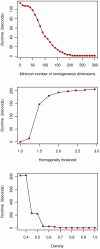Module discovery by exhaustive search for densely connected, co-expressed regions in biomolecular interaction networks
- PMID: 21049092
- PMCID: PMC2963598
- DOI: 10.1371/journal.pone.0013348
Module discovery by exhaustive search for densely connected, co-expressed regions in biomolecular interaction networks
Erratum in
- PLoS One. 2010;5(12) doi: 10.1371/annotation/ab9e87d9-f59c-4dab-aea5-a3c1116d3d85
Abstract
Background: Computational prediction of functionally related groups of genes (functional modules) from large-scale data is an important issue in computational biology. Gene expression experiments and interaction networks are well studied large-scale data sources, available for many not yet exhaustively annotated organisms. It has been well established, when analyzing these two data sources jointly, modules are often reflected by highly interconnected (dense) regions in the interaction networks whose participating genes are co-expressed. However, the tractability of the problem had remained unclear and methods by which to exhaustively search for such constellations had not been presented.
Methodology/principal findings: We provide an algorithmic framework, referred to as Densely Connected Biclustering (DECOB), by which the aforementioned search problem becomes tractable. To benchmark the predictive power inherent to the approach, we computed all co-expressed, dense regions in physical protein and genetic interaction networks from human and yeast. An automatized filtering procedure reduces our output which results in smaller collections of modules, comparable to state-of-the-art approaches. Our results performed favorably in a fair benchmarking competition which adheres to standard criteria. We demonstrate the usefulness of an exhaustive module search, by using the unreduced output to more quickly perform GO term related function prediction tasks. We point out the advantages of our exhaustive output by predicting functional relationships using two examples.
Conclusion/significance: We demonstrate that the computation of all densely connected and co-expressed regions in interaction networks is an approach to module discovery of considerable value. Beyond confirming the well settled hypothesis that such co-expressed, densely connected interaction network regions reflect functional modules, we open up novel computational ways to comprehensively analyze the modular organization of an organism based on prevalent and largely available large-scale datasets.
Availability: Software and data sets are available at http://www.sfu.ca/~ester/software/DECOB.zip.
Conflict of interest statement
Figures

 times the amount of possible edges and its genes are co-expressed in at least
times the amount of possible edges and its genes are co-expressed in at least  different experimental conditions (
different experimental conditions ( ) with a difference of at most
) with a difference of at most  (
( ).
).
 (density).
(density).

 (density),
(density),  (maximum difference in expression) and
(maximum difference in expression) and  (number of expression conditions). The algorithmic strategy is to traverse the lattice of all subnetworks in a breadth-first fashion. Any subnetwork which is not a densely connected biclusters can be discarded due to that every densely connected bicluster necessarily has a densely connected bicluster as a parent ( = subnetwork contained in the original one, see definitions 1 and 3 and the surrounding discussions). For esthetical reasons, we have omitted B-C-D-E although, as a child of the densely connected bicluster B-C-D, it is also examined. B-C-D-E, just as A-B-D-E will be discarded since it violates the density constraint.
(number of expression conditions). The algorithmic strategy is to traverse the lattice of all subnetworks in a breadth-first fashion. Any subnetwork which is not a densely connected biclusters can be discarded due to that every densely connected bicluster necessarily has a densely connected bicluster as a parent ( = subnetwork contained in the original one, see definitions 1 and 3 and the surrounding discussions). For esthetical reasons, we have omitted B-C-D-E although, as a child of the densely connected bicluster B-C-D, it is also examined. B-C-D-E, just as A-B-D-E will be discarded since it violates the density constraint.Similar articles
-
Identification of regulatory modules in genome scale transcription regulatory networks.BMC Syst Biol. 2017 Dec 15;11(1):140. doi: 10.1186/s12918-017-0493-2. BMC Syst Biol. 2017. PMID: 29246163 Free PMC article.
-
Arabidopsis gene co-expression network and its functional modules.BMC Bioinformatics. 2009 Oct 21;10:346. doi: 10.1186/1471-2105-10-346. BMC Bioinformatics. 2009. PMID: 19845953 Free PMC article.
-
BicNET: Flexible module discovery in large-scale biological networks using biclustering.Algorithms Mol Biol. 2016 May 20;11:14. doi: 10.1186/s13015-016-0074-8. eCollection 2016. Algorithms Mol Biol. 2016. PMID: 27213009 Free PMC article.
-
Comparison of single and module-based methods for modeling gene regulatory networks.Bioinformatics. 2020 Jan 15;36(2):558-567. doi: 10.1093/bioinformatics/btz549. Bioinformatics. 2020. PMID: 31287491
-
BinTree seeking: a novel approach to mine both bi-sparse and cohesive modules in protein interaction networks.PLoS One. 2011;6(11):e27646. doi: 10.1371/journal.pone.0027646. Epub 2011 Nov 28. PLoS One. 2011. PMID: 22140454 Free PMC article.
Cited by
-
Dysregulation of complement system and CD4+ T cell activation pathways implicated in allergic response.PLoS One. 2013 Oct 8;8(10):e74821. doi: 10.1371/journal.pone.0074821. eCollection 2013. PLoS One. 2013. PMID: 24116013 Free PMC article.
-
Computational solutions for omics data.Nat Rev Genet. 2013 May;14(5):333-46. doi: 10.1038/nrg3433. Nat Rev Genet. 2013. PMID: 23594911 Free PMC article. Review.
-
Identifying grade/stage-related active modules in human co-regulatory networks: a case study for breast cancer.OMICS. 2012 Dec;16(12):681-9. doi: 10.1089/omi.2012.0015. OMICS. 2012. PMID: 23215806 Free PMC article.
-
Quantitative assessment of gene expression network module-validation methods.Sci Rep. 2015 Oct 16;5:15258. doi: 10.1038/srep15258. Sci Rep. 2015. PMID: 26470848 Free PMC article.
-
Biclustering data analysis: a comprehensive survey.Brief Bioinform. 2024 May 23;25(4):bbae342. doi: 10.1093/bib/bbae342. Brief Bioinform. 2024. PMID: 39007596 Free PMC article. Review.
References
-
- Albert R. Scale-free networks in cell biology. J of Cell Science. 2005;118:4947–4957. - PubMed
-
- Ge H, Liu Z, Church GM, Vidal M. Correlation between transcriptome and interactome mapping data from Saccharomyces cerevisiae. Nature Genetics. 2001;29(4):482–486. - PubMed
-
- de Lichtenberg U, Jensen LJ, Brunak S, Bork P. Dynamic complex formation during the yeast cell cycle. Science. 2005;307:724–727. - PubMed
-
- Tong AHY, Lesage G, Bader GD, Ding H, Xu H, et al. Global Mapping of the Yeast Genetic Interaction Network. Science. 2004;303:808–813. - PubMed
Publication types
MeSH terms
Grants and funding
LinkOut - more resources
Full Text Sources
Molecular Biology Databases

